Kyosho of America SYNCROEX6 Radio control transmitter User Manual 82030 Syncro EX 6 manual EN
Kyosho Corporation of America Radio control transmitter 82030 Syncro EX 6 manual EN
Contents
- 1. 06_1_Users_Manual_rev2
- 2. 06_2_Users_Manual_rev2
- 3. 06_3_Users_Manual_rev2
06_3_Users_Manual_rev2
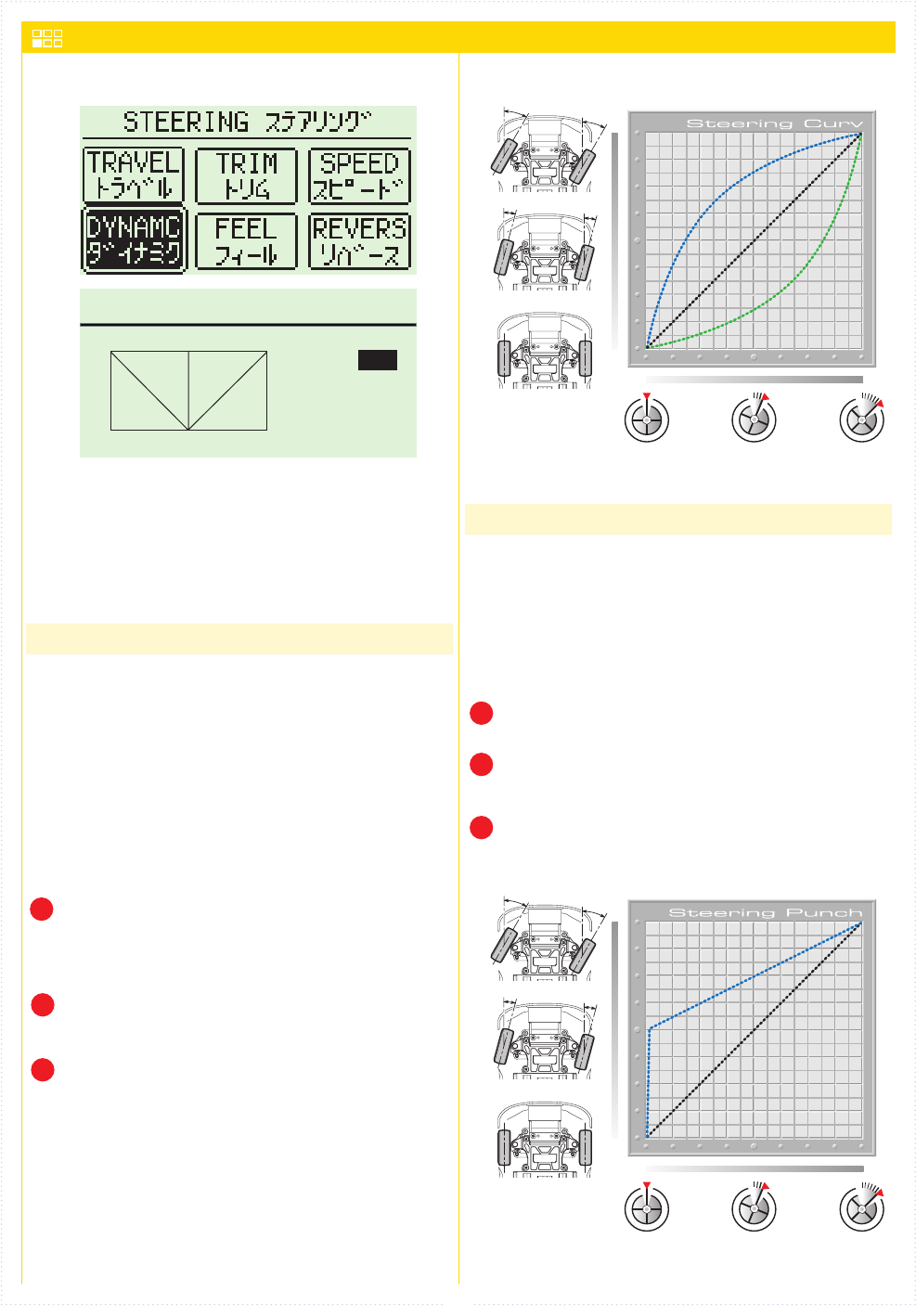
Wheel Movement
Servo Movement Angle
At +50
At 0
Wheel Movement
Servo Movement Angle
At +100
At −100
At 0
41
CURVE
%
PUNCH
%
カーブ
パンチ
0
0
N
LR
ST DYNAMICS ダイナミクス
DYNAMC Steering Dynamics
Settings related to steering control.
▶ CURVE Steering Curve
Modify the movement speed ratio which corresponds to
steering angle.
▶ PUNCH Steering Punch
Modify how much the steering initially turns from neutral
position.
▶
CURVE Steering Curve
▶ PUNCH Steering Punch
This function adjusts the ratio of the steering angle
to servo movement speed (Curve Characteristics).
Choose between (+) Quick Curve and (-) Mild Curve.
This function quickens the steering's initial response
and can be used to instill a strong turning movement
when the steering initially moves from neutral.
【Setting Range】
ST CURVE : -100 〜 0 〜 100%
(Default : 0%)
【Setting Range】
ST PUNCH : 0 〜 50%
(Default : 0%)
【Example】
Modify the movement speed ratio which corresponds to
steering angle.
As the graph shows, servo movement speed can be
changed according to wheel movement angle.Positive
values (+1 to +100) equal high initial response followed
by mild response. Negative values (-1 to -100) equal a
mild initial response followed by high response.
P
The larger the value, the stronger the amount of turning
movement.
P
When using this in conjunction with other functions such as
[Steering Speed], adjust one at a time to conrm their eects
to produce an eective overall setting.
P
To adjust only the steering's initial response, use the
[Steering Punch] function.
P
This could be eective if steering linkages have a lot of
slop, but please note that it does not improve straight-
line performance.
P
When using this in conjunction with other functions such
as [Steering Speed], adjust one at a time to conrm their
eects to produce an eective overall setting.
P
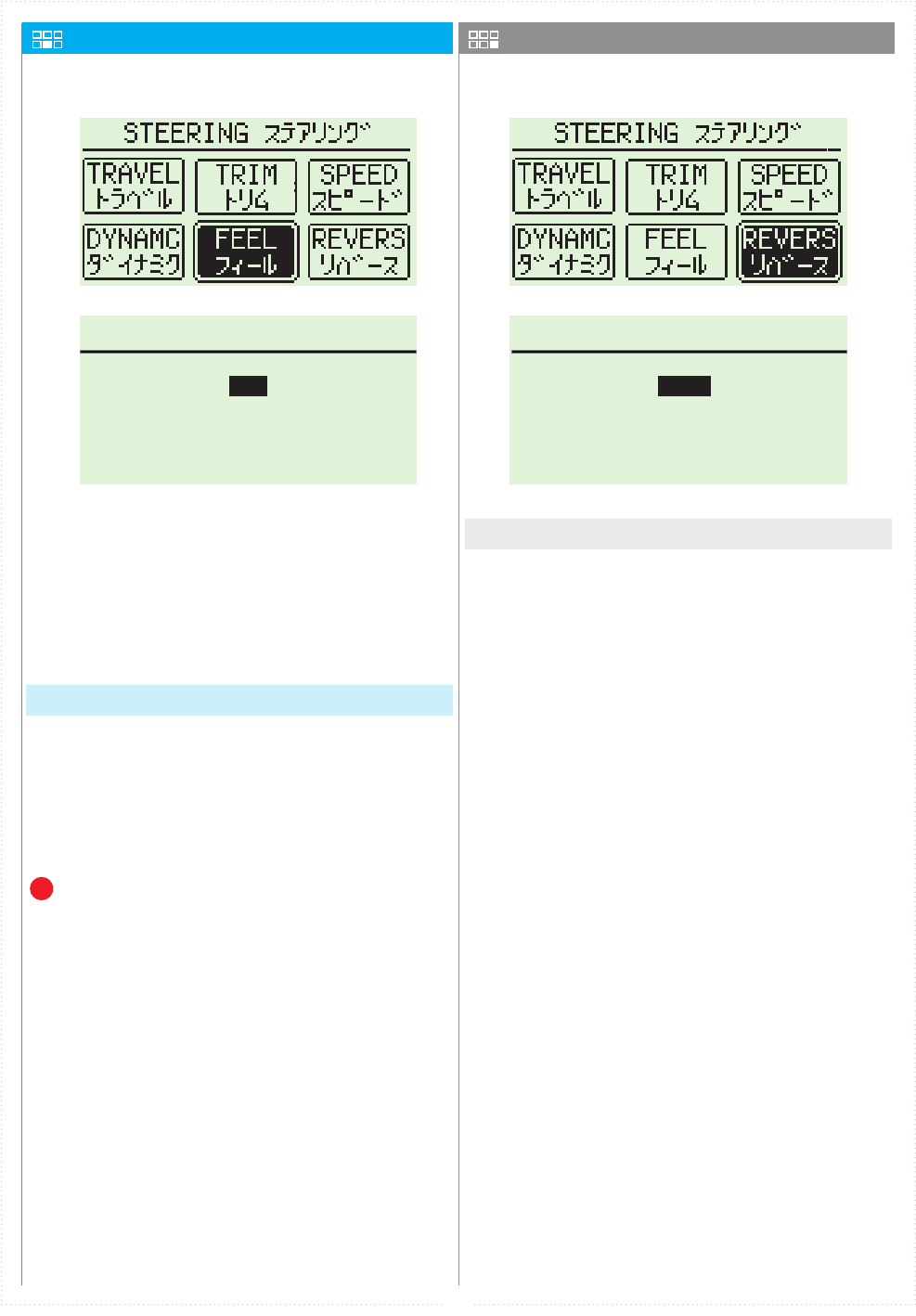
42
ST FEEL
TH FEEL
ステアリングフィール 0
B
F
スロットル フィール
0
0
FEEL フィール
ST REVERSE
TH REVERSE
ステアリングリバース
NORM
スロットル リバース
NORM
REVERSE リバース
FEEL Steering feel MENU REVERSE Steering Reverse
FEEL function provides changing the moving
peformance of steering servo.
▶ ST FEEL Steering Feeling
Adjust steering feeling.
▶ TH FEEL F Throttle feel F
Refer to "Throttle Feel F" (p.47)
▶ TH FEEL B Throttle feel B
Refer to "Throttle Feel B" (p.47)
▶
ST FEEL Steering Feel
▶
ST REVERSE Steering reverse
FEEL function provides changing the cornering
peformance feeling.
Modify the steering direction.
【Setting Range】
ST FEEL : -50 〜 0 〜 50%
(Default: 0%)
【Setting Range】
ST REVERSE :NORM(Normal), REVS(Reverse)
(Default : NORM)
TH REVERSE :
Refer to "Throttle Reverse" (p.48)
Take into account such factors as the car, driving
surface, etc. when adjusting Steering feel settings.
Conduct test drives to nd the best setting values.
P
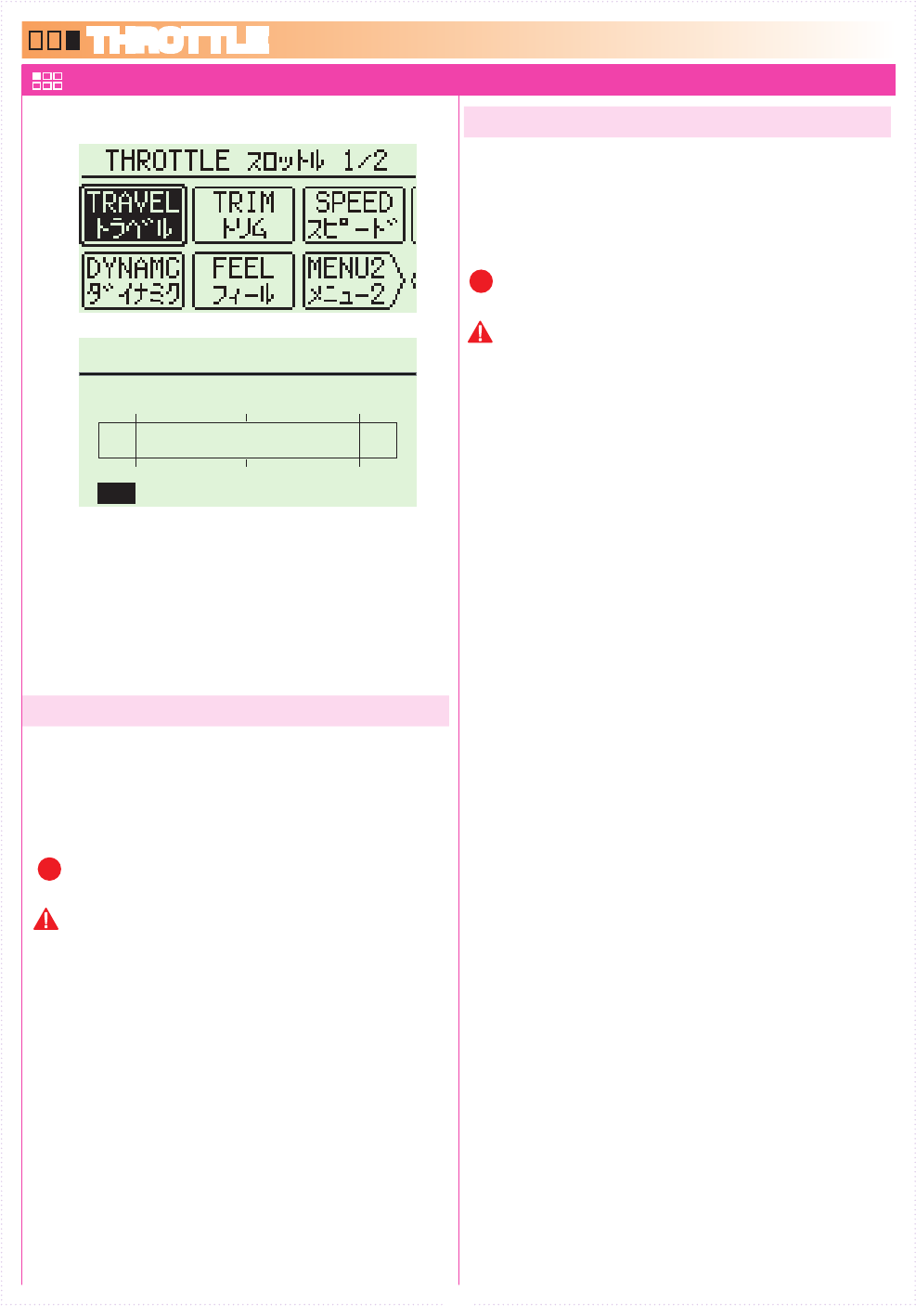
43
N
B100%
TH TRAVEL
F 100 %
TH TRAVEL トラベル
THROTTLE
TRAVEL Throttle Travel
Settings related to throttle control.
▶ TH TRAVEL F Throttle Travel F
Modify the maximum amount of throttle movement
(towards forward acceleration).
▶ TH TRAVEL B Throttle Travel B
Modify the maximum amount of throttle brake movement.
Adjust the maximum amount of throttle forward
acceleration movement.
▶
TH TRAVEL F Throttle Travel F
The key setting displays [T:HIPOINT].
P
Throttle will not operate if the High Point value is set to
0.
Brake will not operate if the BRAKE value is set to 0.
Adjust the maximum amount of brake movement.
【Setting Range】
TH TRAVEL F : 0 〜 150
(Defaul : 100)
【Setting Range】
TH TRAVEL B : 0 〜 150
(Default : 100)
▶
TH TRAVEL B Throttle Travel B
The key setting displays [T:BRAKE].
P
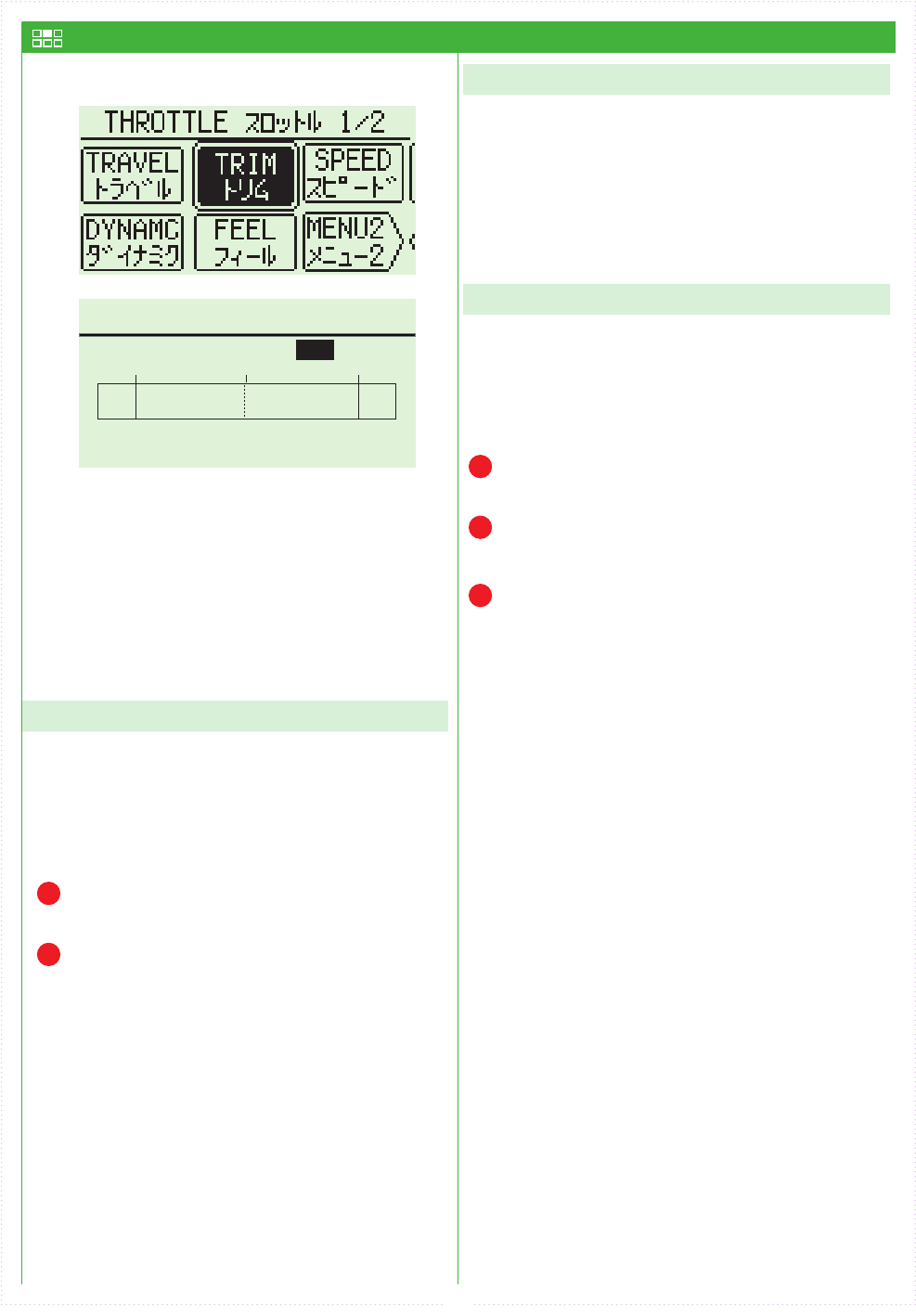
44
TH SUBT R I M
TH TRIM : 0
トリム
サブトリム
: 0
TH TR I MRAT E
トリムレート
: 5
TH TRIM トリム
TRIM Throttle Trim
Settings related to throttle control.
▶ TH TRIM Throttle Trim
Modify the neutral position of the throttle.
▶ TH SUBTRIM Throttle Subtrim
Shift the overall throttle movement range.
▶ TH TRIMRATE Throttle Trimrate
Modify the amount of movement which corresponds to
one click of the throttle trim button.
Adjusts the neutral/center position of the throttle
range.
▶
TH TRIM Throttle Trim
Setting adjustments prior to driving should be carried
out with the sub trim, not the trim.
P
The setting range cannot exceed what is set by [Throttle
Travel F] or [Throttle Travel B].
P
Adjust the position of the overall throttle movement
range.
※ Also refer to Trim and Sub Trim Operation. (p.13)
Adjusts the amount of movement associated with
one click of the throttle trim button.
【Setting Range】
TH TRIM : F50 〜 0 〜 B50
(Default : 0)
【Setting Range】
TH SUBTRIM : F80 〜 0 〜 B80
(Default : 0)
【Setting Range】
TH TRIM RATE : 1 〜 10
(Default : 5)
▶
TH SUBTRIM
Throttle Subtrim
TH TRIMRATE Throttle Trimrate
The amount of movement of one interval can be
adjusted, the lower the number the smaller the amount
of movement.
The overall number of intervals does not change, so a
change in trim rate will result in a change in the range in
which the trim can be used to make corrections.
If the trim rate is changed when the trim is already set,
the trim may be thrown o. If the trim setting is 0 then
this does not apply.)
P
P
P
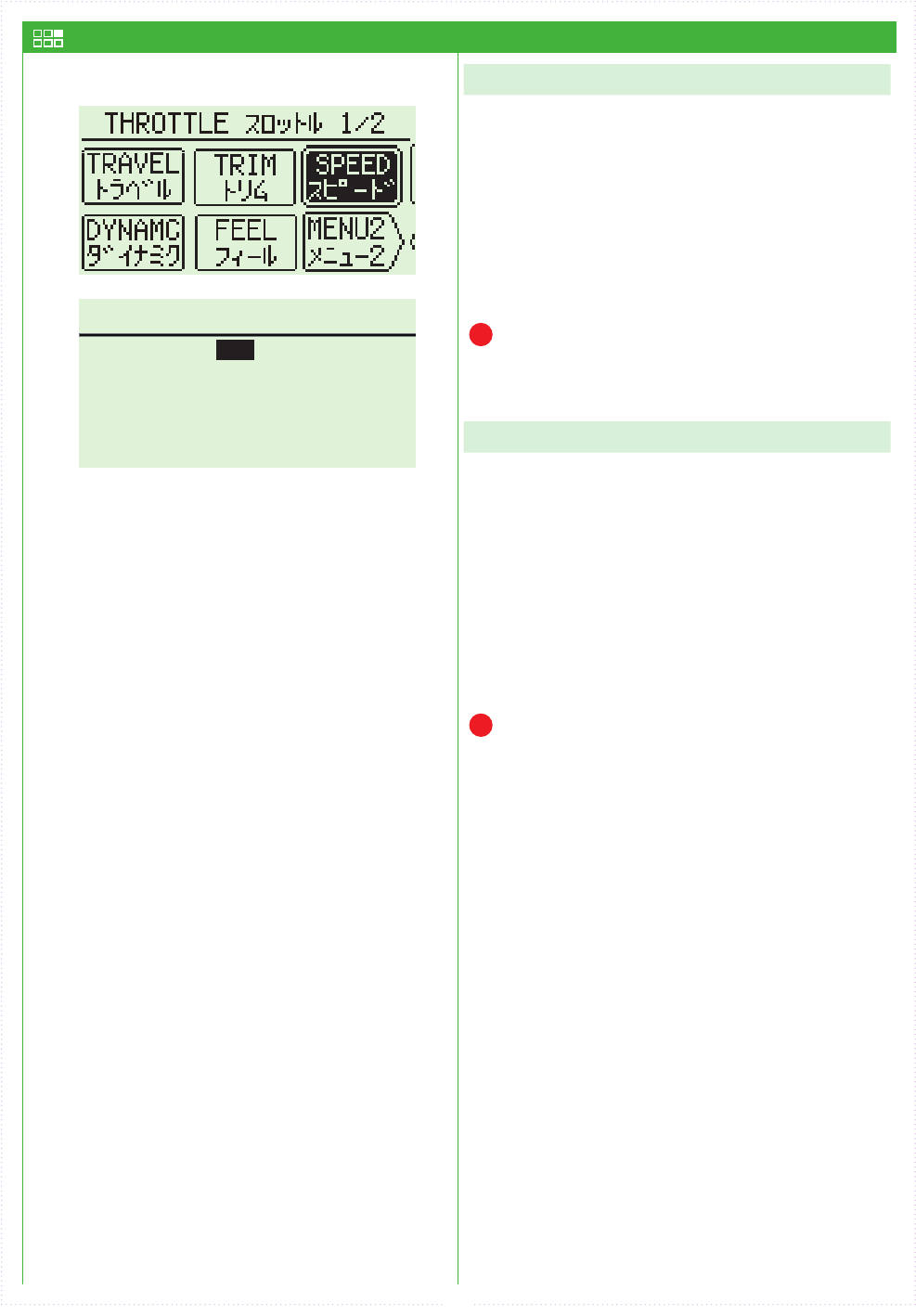
45
TH TURN 100
%
TH RETURN 100
%
ターンスピード
リターンスピード
TH SPEED スピード
TH SPEED Throttle Speed
Settings related to throttle control.
▶ TH TURN Throttle Turn Speed
Modify the speed of the throttle's movement (towards
forward acceleration).
▶ TH RETURN Throttle Return Speed
Modify the speed of the throttle's return movement.
This function delays the conversion of the throttle
control signal to make the car easier to control.
This function delays the conversion of the throttle
control signal to make the car easier to control.
※ The [TURN] direction is adjusted with [Throttle
Turn Speed].
【Setting Range】
TH TURN SPEED : 1 〜 100%
(Default : 100%)
【Setting Range】
TH RETURN SPEED : 1 〜 100%
(Default : 100%)
▶
TH TURN Throttle Turn Speed
TH RETURN Throttle Return Speed
For each setting, it has changed the optimal numerical
value in a variety of factors, such as your car, the road
surface. Conduct test drives to find the best setting
values.
P
For each setting, it has changed the optimal numerical
value in a variety of factors, such as your car, the road
surface. Conduct test drives to find the best setting
values.
P
【Example】
If the car spins or otherwise does not drive straight
when the throttle is applied suddenly, limiting the
throttle speed can be eective.
【Example】
If the car spins or otherwise does not drive straight
when the throttle is lowered suddenly, limiting the
throttle speed can be eective.

HalfNeutral Full Throttle
Quick
Mild
Trigger Movement
ESC accelerator opening
At +100
At −100
At 0
HalfNeutral Full Throttle
Trigger Movement
ESC accelerator opening
At 80
At 50
At 0
46
CURVE
%
PUNCH
%
カーブF
パンチF
0
0N
FB
カーブB
パンチB
%
0
%
0
TH DYNAMICS ダイナミクス
DYNAMC Throttle Dynamics
Settings related to throttle control.
▶ CURVE F Throttle Curve Forward
Modify the movement speed ratio which corresponds to
how much throttle is applied.
▶ CURVE B Throttle Curve Brake
Modify the movement speed ratio which corresponds to
how much throttle brake is applied.
▶ PUNCH F Throttle punch Forward
Modify how much the throttle initially accelerates from
neutral position.
▶ PUNCH B Throttle punch Brake
Modify how much the brake initially accelerates from
neutral position.
This function sets the signal conversion rate to a
curve to enable quicker or milder response. Likewise,
braking can also be set to a braking curve.
This function quickens the throttle's initial response
and can be used to instill a sense of power when the
throttle initially moves from neutral.
【Setting Range】
TH CURVE F : -100 〜 0 〜 100%
(Default : 0%)
TH CURVE B : -100 〜 0 〜 100%
(Default : 0%)
【Setting Range】
TH PUNCH F : 0 〜 50%
(Default : 0%)
TH PUNCH B : 0 〜 50%
(Default : 0%)
▶ CURVE Steering Curve
▶ PUNCH Throttle Punch
When [Throttle Punch] is activated, the characteristics
of the throttle curve value is also added to the Throttle
Punch value.
The larger the value, the larger the amount of throttle
movement. However, depending on other settings, the
throttle operation may become jagged.
When using this in conjunction with other functions,
adjust one at a time to conrm their eects to produce
an eective overall setting.
This function adjusts only the curve. Use the [Throttle
Punch] function if you wish to adjust the initial response.
Positive values (+1 to +100) equal high initial response
followed by mild response.
Negative values (-1 to -100) equal a mild initial response
followed by high response.
If using this in conjunction with other functions such as
[Throttle ABS], conrm the operation before using.
P
P
P
P
P
P
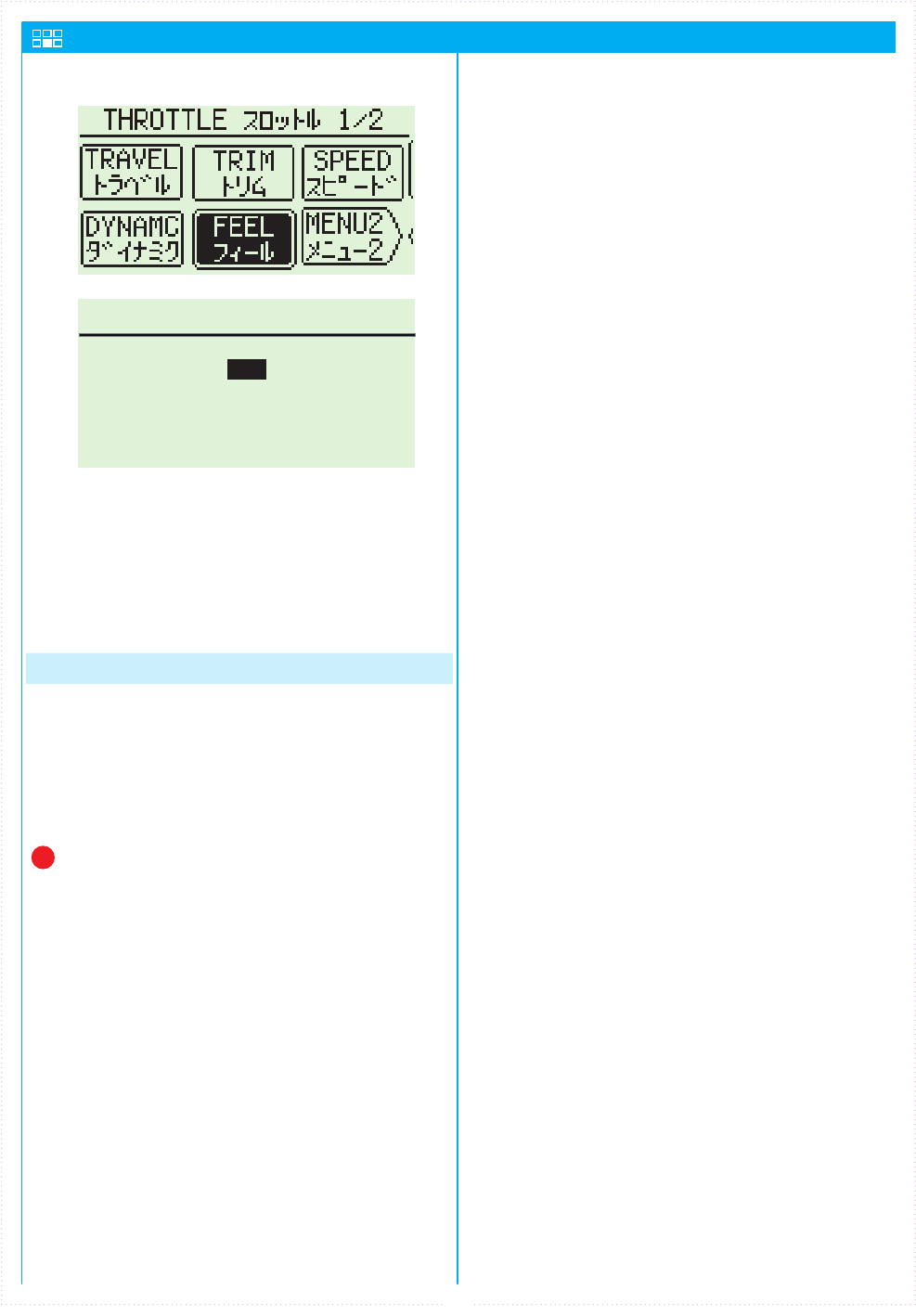
47
ST FEEL
TH FEEL
ステアリングフィール 0
B
F
スロットル フィール
0
0
FEEL フィール
FEEL Throttle feel MENU
FEEL function provides changing the throttle feeling.
▶ ST FEEL Steering Feeling
Refer to "Steering Feel " (p.42)
▶ TH FEEL F Throttle feel F
Adjust forward throttle feeling.
▶ TH FEEL B Throttle feel B
Adjust brake feeling.
FEEL function provides changing the throttle feeling.
【Setting Range】
TH FEEL F : -50 〜 0 〜 50%
(Default : 0%)
TH FEEL B : -50 〜 0 〜 50%
(Default : 0%)
▶ TH FEEL Throttle feel
Take into account such factors as the car, driving
surface, etc. when adjusting throttle feel settings.
P
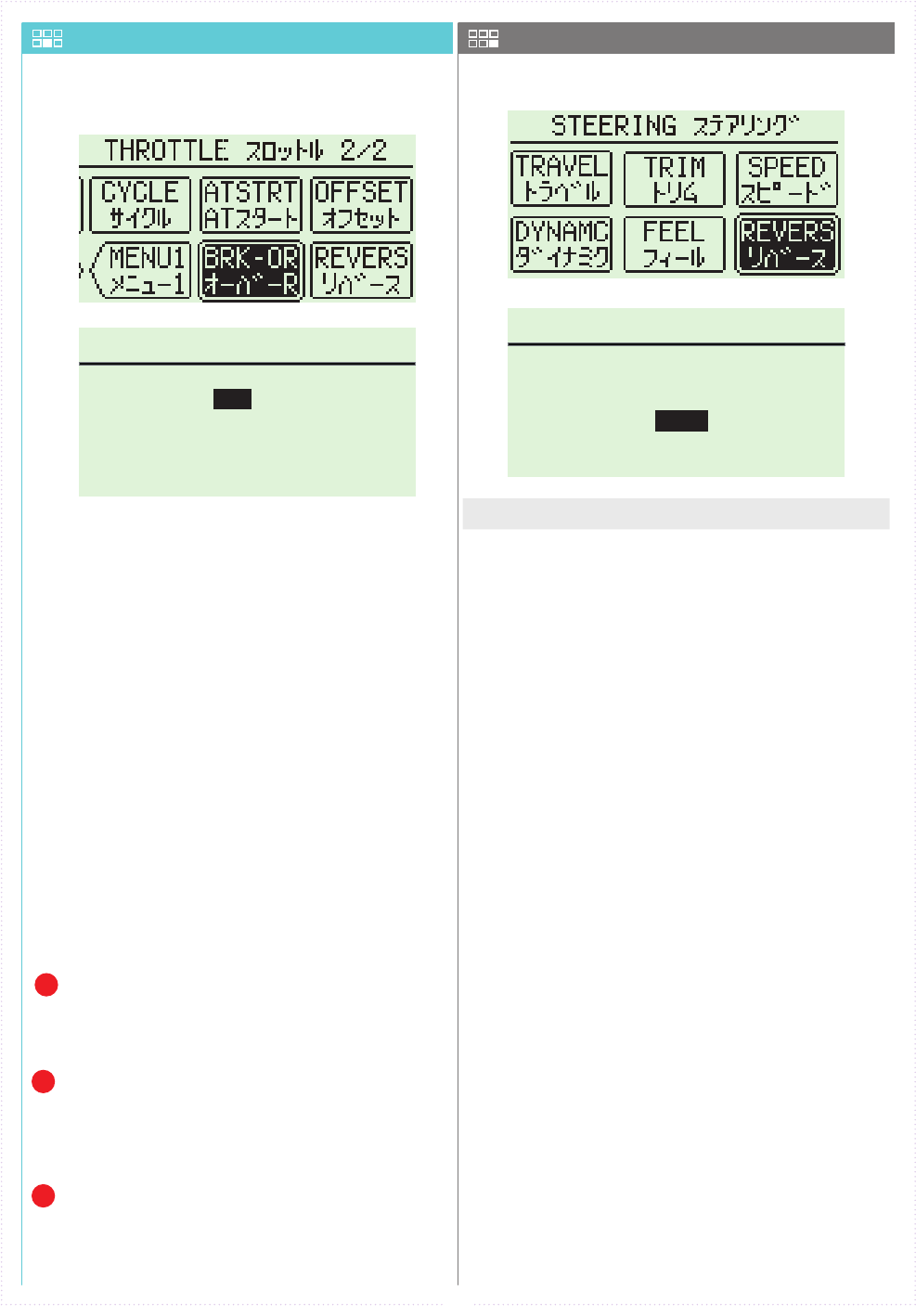
48
KEY
キー
0FF
BRAKE
ブレーキ
100
STTRAVEL
STトラベル
100
OVERRIDE オーバーライド
OVERRIDE Throttle Override REVERSE Throttle Reverse
Arrange another maximum brake setting and steering
travel setting, which can be activated/deactivated by
the ET lever or BT button.
▶ KEY Key
Assigns a key to be used to activate/deactivate the override.
▶ BRAKE Brake
Sets the brake override's brake setting.
▶ ST TRAVEL Steering Travel
Adjust the steering angle according to the driving
conditions to make the car easier to control.
【Setting Range】
KEY : OFF, ET1 〜 5, BT1
(Default : OFF)
BRAKE : 0 〜 150
(Default : 100)
ST TRAVEL : 0 〜 150
(Default : 100)
When you only want to change the brake override set
point, the numerical value of the steering travel override
becomes eective at the same time.
Please input the same numerical value for the steering
travel and the steering travel override when you do not
want to change a value of the steering travel.
When you only want to change the Steering travel
override set point, the numerical value of the brake
override becomes eective at the same time.
Please input the same numerical value throttle travel B
and the brake override when you do not want to change
a value of the brake travel.
P
P
【Example(throttle brake override)】
If a change in driving conditions is foreseen, the
throttle brake setting can be changed during driving.
【Example(Steering travel override)】
Convenient for changing the steering angle on
straights to give the car better straight-line stability.
[OR] Display on the Function Monitor!
Operating the key that is assigned by [KEY] will result
in [OR] being displayed on the initial screen's function
monitor. If that key is pressed while at the initial screen,
[OR] will disappear from the function monitor.
P
ST REVERSE
TH REVERSE
ステアリングリバース
NORM
スロットル リバース
NORM
REVERSE リバース
▶
TH REVERSE Throttle reverse
Modify the throttle direction.
【Setting Range】
ST REVERSE :
Refer to "Steering Reverse" (p.42)
TH REVERSE :
NORM(Normal), REVS(Reverse)
(Default : NORM)
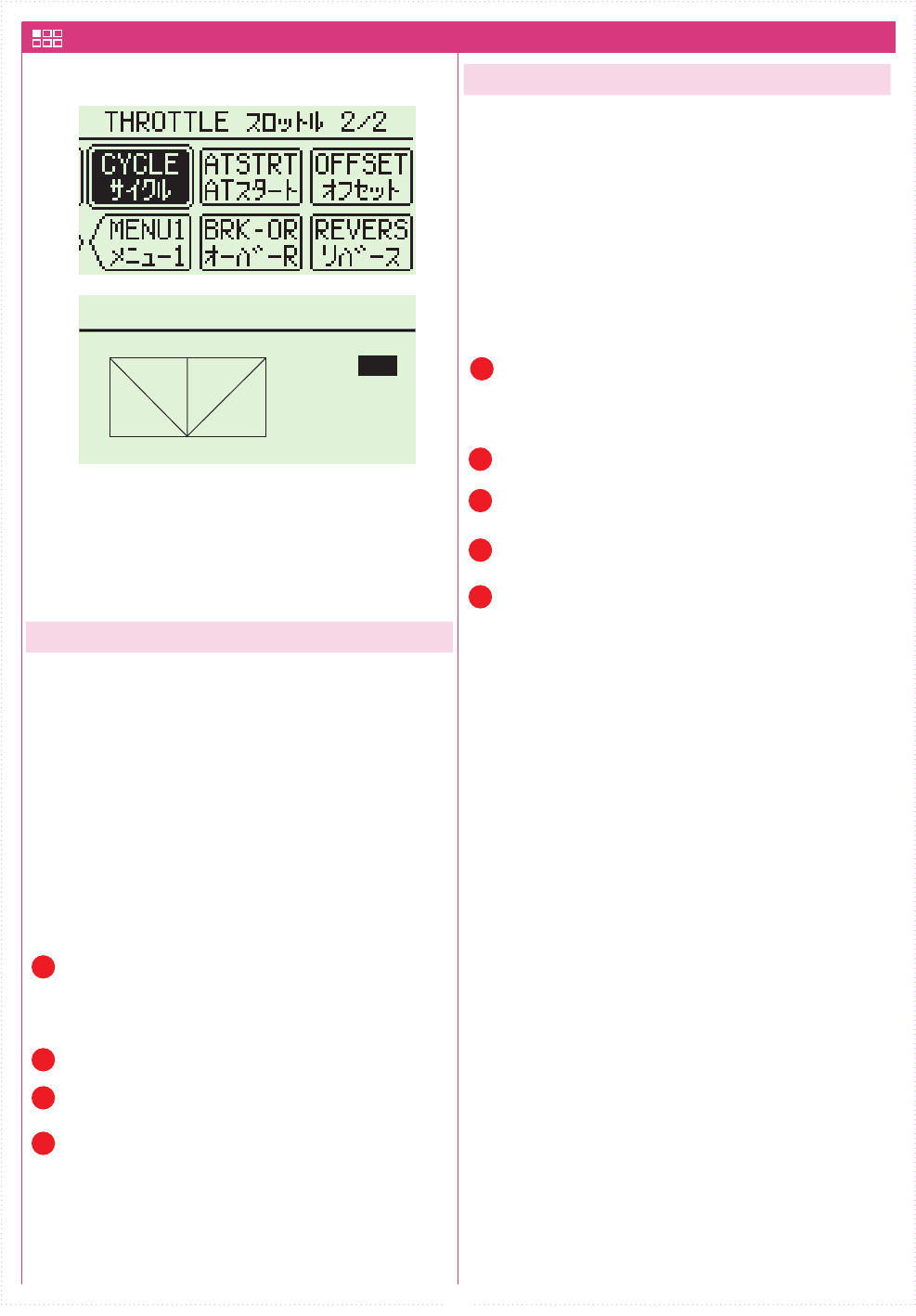
49
ACCEL
ABS
WIDTH
0FF
N
FB
CYCLE
OFF
15
WIDTH
CYCLE
15
%
%
CYCLE サイクル
CYCLE Throttle Cycle
Add a change to the operation of throttle brakes.
▶ ACCEL Throttle Acceleration
Modify the amount of acceleration burst of the throttle.
▶ ABS
Modify the amount of brake pumping.
Just like professional drivers who are capable of
precise throttle inputs, this function enables ne
throttle adjustments to allow quicker cornering.
To prevent tires from locking up during sudden braking,
brake pumping will be applied.
【Setting Range】
WIDTH : OFF 〜 100%
(Default : OFF)
CYCLE : 1 〜 30
(Default : 15)
【Example】
By setting the throttle to feather automatically, the
car could be made to grip and corner faster on low-
grip surfaces.
【Example】
This function is eective when your car's wheels lock
up under braking and disturbs the car's balance. It
will help enable smooth cornering performance.
【Setting Range】
WIDTH : OFF 〜 100%
(Default : OFF)
CYCLE : 1 〜 30
(Default : 15)
▶ ACCEL Throttle Acceleration
▶ ABS
[CYC] Display on the Function Monitor!
If [WIDTH] is not set to OFF, [CYC] will be displayed on
the initial screen's function monitor. If the key assigned
to CYCLE is pressed while at the initial screen, [CYC] will
disappear from the function monitor.
[CYC] Display on the Function Monitor!
If [WIDTH] is not set to OFF, [CYC] will be displayed on
the initial screen's function monitor. If the key assigned
to CYCLE is pressed while at the initial screen, [CYC] will
disappear from the function monitor.
If [CYCLE] is set at a large value, the ESC operation
frequency will increase.
How effectiveness of actual ABS is different in your
vehicle performance.
When "ACCEL" and "ABS" either one or both become
eective, "CYC" is displayed at the same position of the
initial screen.
If [CYCLE] is set at a large value, the ESC operation
frequency will increase.
For each setting, different optimal numerical value in a
variety of factors, such as your car, the road surface.
Conduct test drives to nd the best setting values.
Setting [WIDTH] to 0 will deactivate Acceleration.
Setting [WIDTH] to 0 will deactivate ABS.
P
P
P
P
P
P
P
P
P
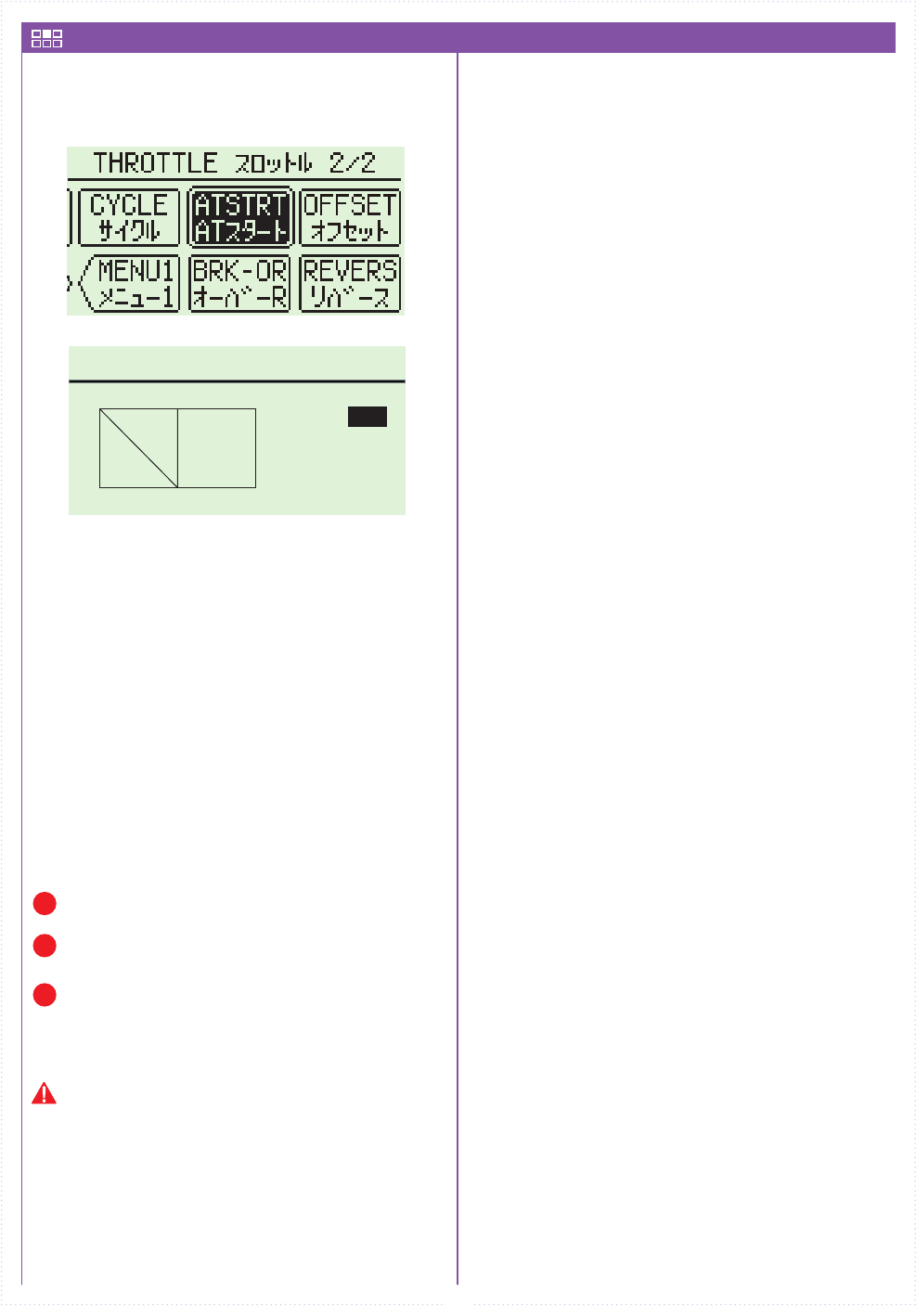
50
KEY
ポジション
キー
0FF
N
FB
TRG.P
100
FORWARD
パワー
5
%
%
AUTOSTART オートスタート
ATSTRT Throttle Auto-Start
This function sets the throttle output to a xed
level at startup, regardless of how much the throttle
trigger is pulled.
① Assain KEY (ET1-5/BT1).
② Operate an assigned key and validate [autostart].
③ Operate the throttle trigger and the launching
starts when throttle trigger reaches [TRG.P].
【Example】
Launching from the starting line.
【Setting Range】
KEY : OFF, ET1 〜 5, BT1
(Default : OFF)
TRG.P : 5 〜 100%
(Default : 5%)
FORWARD : 0 〜 100%
(Default : 100%)
[AUT] Display on the Function Monitor!
If the key assigned to Auto-Start is pressed, [AUT] will
be displayed on the initial screen's function monitor. If
this key is pressed while at the initial screen, [AUT] will
disappear from the function monitor.
The function will not operate until the throttle trigger
reaches the set position.
When the throttle is released, the function is deactivated
and the throttle returns to normal operation.
P
P
P
Normally, full throttle is set for launching from the
starting line. However, tire and surface conditions may
mean full throttle will not be eective. Conduct tests and
make adjustments
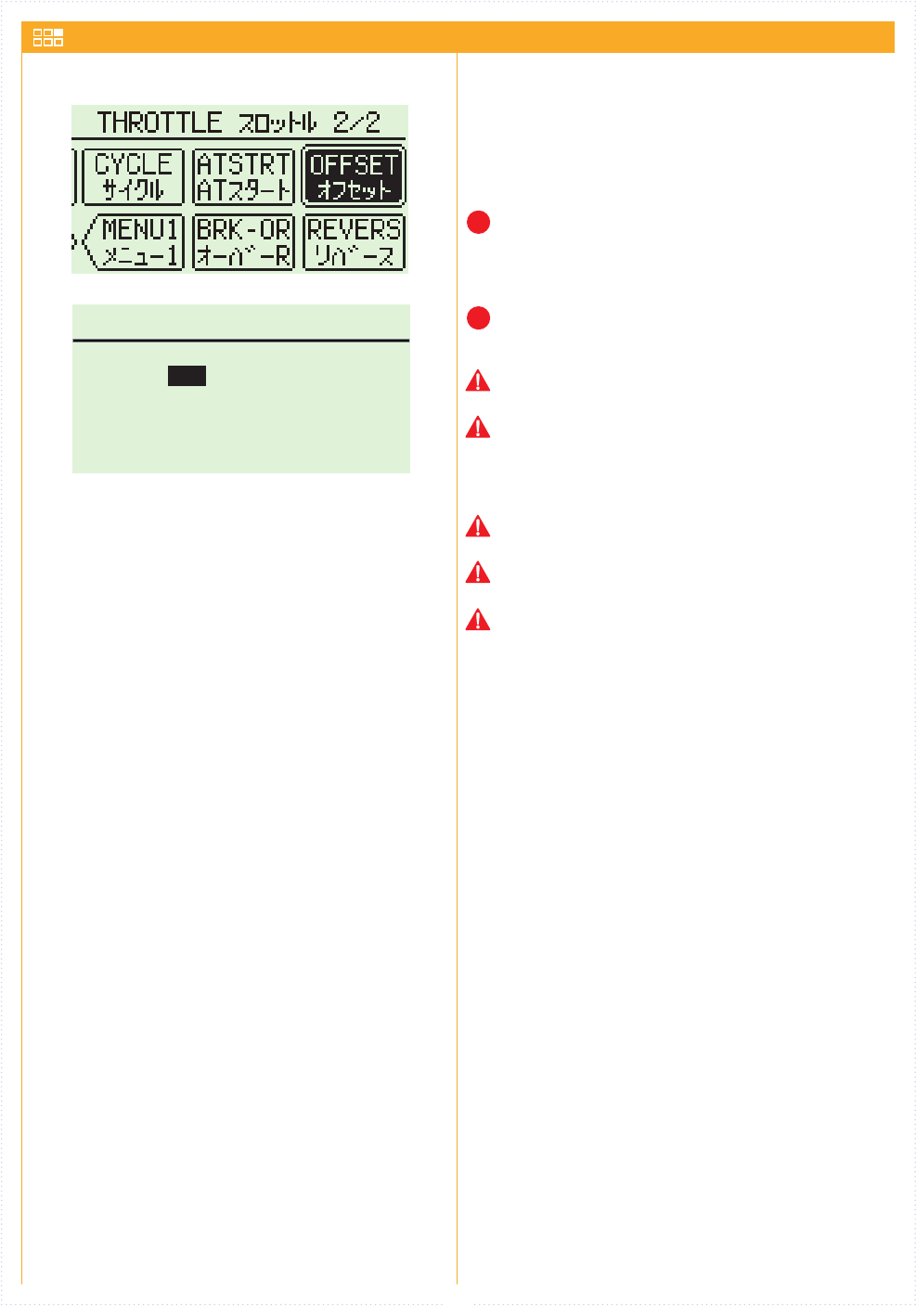
51
KEY
ボタン
キー
0FF
BUTTON
TGLE
MODE
モード
N . BRK
%
OFFSET
オフセット
OFFSETKEY
オフセットキー
OFF
OFF
OFFSET オフセット
OFFSET Throttle OFFSET
Used to oset the throttle's neutral position.
【Example(Neutral brake)】
This function enables a light brake application at the
moment when the throttle position changes from
acceleration to deceleration.
【Setting Range】
OFFSET(Neutral brake) : -100 〜 OFF
(Default : OFF)
OFFSET(Idle up) : -100 〜 OFF 〜 100
(Default : OFF)
MODE : N.BRK, I.UP
(Default : N.BRK)
OFFSETKEY : OFF, ET1 〜 5
(Default : OFF)
KEY : OFF, ET1 〜 5, BT1
(Default : OFF)
BOTTON : TGLE, PUSH
(Default : TGLE)
[OFS] Display on the Function Monitor!
If the key assigned to OFFSET is pressed, [OFS] will
be displayed on the initial screen's function monitor. If
this key is pressed while at the initial screen, [OFS] will
disappear from the function monitor.
Throttle can be operated even when Idle Up is activated.
The throttle travel F/B point does not change during this
time.
P
P
When the EX-6 is turned o in the state of the OFFSET
effect and transmitter is switched back on again, the
function of OFFSET becomes invalid due to the safety
precautions. Please activate eect again in KEY which
you assigned it to.
If you set a large value of the drag brake, please note
that it may be back running in neutral.
If you set a large value of the drag brake, it may not be
back traveling.
If you set a large value of the idle-up, it may not be back
traveling.
Cannot use the function of "N.BRK" and "I.UP" both at
the same time.
▶ OFFSET Throttle OFFSET
Sets the amount of neutral oset.
▶ MODE OFFSET MODE
Choice N.BRK (neutral brakes) or I.UP (idol up.)
▶ OFFSETKEY Throttle OFSET KEY
Assigns a key to be used to change the amount of
neutral oset.
▶ KEY
Assigns a key to be used to activate/deactivate the
OFFSET Function.
▶ BUTTON
Sets the method of activation.
TGLE:If a key is assigned to Idle Up, press once to
activate and press again to deactivate.
PUSH:It is only activated when the key is pushed and
held. The operations is deactivated when Key is released.

A radio frequency range which is higher than previous ones such as 27MHz and 40MHz.
However, this also means it is also more direct and signal transmission may be difficult if there
are interfering objects between the transmitter and receiver.
A feature which changes the steering angle of all four wheels according to the driving
condition to enable greater stability.
One of the radio frequency ranges used for the R/C hobby. 12 bands exist for both
ground-based and airborne R/C models.
One of the radio frequency ranges used for the R/C hobby. 8 bands and 5 bands are assigned
for use with ground-based and airborne R/C models respectively.
A battery charger which plugs into the standard 100V wall socket (in Japan). It often requires
charging times of several hours or more.
A buzzer sound emitted by the transmitter. It may be used as a warning notification, etc.
See ESC.
A type of servo which uses analog-type integrated circuits (IC).
Since LCDs do not generate their own light and are difficult to see in dark places, this light is
placed beneath it to illuminate the display.
Another word for radio frequency. This can be set with frequency crystals and different crystals
can dictate the frequencies used in a certain frequency range.
An item which indicates to others the frequency that a particular user is using.
The repeated action of applying and releasing the brakes.
A trim which only adjusts the position of neutral without disturbing the overall range of travel.
Refers to the number of servos, etc. which can be controlled by a transmitter or their individual
signal numbers.
An electric circuit contact unit which can be connected/disconnected.
The core of a computer which performs digital calculations for various uses. Also sometimes
called an MPU.
A device which sets the frequency used by a transmitter. 27MHz and 40MHz systems require
crystals for changing frequencies while DSSS and FHSS 2.4GHz systems do not.
A marker on the display which indicates the position in the text which can be controlled at
that time.
A process which returns to the beginning and repeats itself.
A battery charger which uses a 12V battery or other stable 12V power source.
An area in which transmitter wheel or trigger movement does not result in servo operation. It
could be caused by worn out components and may be resolved using VRADJ.
When an operation is slow, or has been slowed.
A type of servo which uses digital-type integrated circuits (IC).
A device which forcibly discharges remaining electricity from batteries such as Ni-Cd.
Acronym for Direct Sequence Spread Spectrum. It is a type of spread spectrum transmission
system which uses the 2.4GHz band.
A ratio between two operations.
A type of memory in which stored data is not deleted when the power is turned off. This
product features this type of memory.
An acronym for Electronic Speed Controller, which controls the speed of the motor on an
electric-powered R/C car.
An acronym for Electric Trim. Button Trim is similarly shortened as BT.
A high-end servo in which the motor features field-effect transistors as opposed to bipolar
transistors.
Acronym for Frequency-Hopping Spread Spectrum. Like DSSS, it is a type of spread spectrum
transmission system.
A range of radio wave frequencies such as 27MHz, 40MHz, 2.4GHz, etc.
This system is unique to KO Propo and enables two-way communication with a PC. By using
the Interface Kit (sold separately), the transmitter's internal memory data may be edited on a
PC.
A global communications network which connects smaller networks made up of multiple PCs.
This network enables the release of information via websites around the world,
communication via E-mail, etc.
Acronym for Liquid Crystal Display. The screen is used to display letters, numbers, etc.
Acronym for Light Emitting Diode. It is a type of semi-conductor which uses electricity to
generate light.
A component which connects the servo to another part of the car chassis.
A type of battery which is quick to charge and is good for repeated recharges. They are also
less susceptible to natural discharging and are easy to manage, making them safer compared
to other types of lithium batteries.
A type of lithium battery which is lightweight and available in various sizes. They are equipped
with balance connectors since there is a risk of fire/explosion if they are overcharged.
A unit of frequency. 1000 Hertz (Hz) = 1 Kilohertz (kHz), 1000 kHz = 1 MHz.
A term which refers to a location where information is temporarily stored (on a PC for
example). Transmitters feature non-volatile memory where the stored information is not
erased when power is turned off (refer to EEPROM).
A feature which combines the signals for multiple operations or effects into a more efficient
output signal.
A function which checks the operation of each channel.
The position of the transmitter controls when they are not operated, or the position of the
servo horn at that time.
A feature where braking is applied when the throttle is returned from forward acceleration to
neutral position. Also called drag brake.
A type of battery which can be recharged for repeated use. Other types of rechargeable
batteries include Ni-MH and Li-ion.
Compared to Ni-Cd batteries, Ni-MH batteries have a larger capacity. They are more
environmentally-friendly since it does not contain Cadmium, but they are also more
susceptible to damage from overdischarging.
Electrical interference. Since it is a type of frequency, it could cause the receiver to operate in
error.
When a high-priority (1CH / 2CH) function setting is switched to a low-priority one.
The act of writing a 2.4GHz transmitter's ID into a receiver so that the receiver only chooses to
receive that transmitter's signals. This must be done once before a transmitter is used.
An adapter used to connect a transmitter to a PC to enable the adjustment of the former's
settings on the latter.
The act of specifying a setting position in advance.
Japanese language abbreviation of proportional. Refers to an R/C transmitter or the
transmitter/receiver combination.
A charger which could recharge Ni-Cd, Ni-MH, etc. batteries in a short amount of time.
A device which receives radio signals from the transmitter and passes them on to the servo
and ESC. Use of the same type of signal as the transmitter is required.
A circuit which stabilizes the input voltage to the level of the required voltage.
Returning the settings to the original preset condition.
The time between a transmitter input and a receiver reaction.
A component which generates and transmits radio frequencies. They exist in 27MHz, 40MHz,
2.4GHz (DSSS), and 2.4GHz (FHSS) types, with some transmitters allowing modules to be
interchanged.
A device which translates the transmitter's radio signals into mechanical rotational movement.
A list which describes the makeup, performance, etc. of a piece of R/C equipment.
Adjusts the overall steering angle range.
※Refer to Trim and Sub Trim Usage
A repeated action between two set points.
A measure of the force at work in the rotating shafts of motors, servos, etc.
A device which sends out radio waves to a receiver linked to servos, ESCs, etc. to control an
R/C model.
The angle/amount of servo horn movement.
A mechanism on a transmitter which looks like a gun trigger, the operation of which controls
the throttle.
A mechanism which adjusts the neutral position of each channel.
Acronym for Variable Resistor. An electrical component which senses the position of the
steering, throttle, etc.
Places on the internet on which information is disseminated. They are accessed via PC
software called web browsers. Some websites are also known as homepages.
A mechanism on a transmitter which is rotated left and right to control steering.
The range within which the ABS or throttle operates.
2.4GHz
4WS
27MHz
40MHz
AC Charger
Alarm
Amp
Analog Servo
Backlight
Band
Band ID Tag
Brake Pumping
Center Trim
Channel
Connector
CPU
Crystal
Cursor
Cycle
DC Charger
Dead Zone
Delay
Digital Servo
Discharger
DSSS
Duty Cycle
EEPROM
ESC
ET
FET Servo
FHSS
Frequency Range
ICS (Interactive
Communication System)
Internet
LCD
LED
Linkage
Lithium-Ferrite (Li-Fe)
Battery
Lithium-Polymer (Li-Po)
Battery
Megahertz (MHz)
Memory
Mixing
Monitor
Neutral
Neutral Brake
Ni-Cd
Ni-MH
Noise
Override
Pairing
PC Interface
Preset
Propo
Quick Recharger
Receiver (RX)
Regulator
Reset
Response
RF Module
Servo
Spec List
Sub Trim
Swing
Torque
Transmitter (TX)
Travel
Trigger
Trim
VR
Website
Wheel
Width
52
■ Glossary
This section explains terms which appear in this instruction manual as well as terms which are
common in the radio control hobby.

A radio frequency range which is higher than previous ones such as 27MHz and 40MHz.
However, this also means it is also more direct and signal transmission may be difficult if there
are interfering objects between the transmitter and receiver.
A feature which changes the steering angle of all four wheels according to the driving
condition to enable greater stability.
One of the radio frequency ranges used for the R/C hobby. 12 bands exist for both
ground-based and airborne R/C models.
One of the radio frequency ranges used for the R/C hobby. 8 bands and 5 bands are assigned
for use with ground-based and airborne R/C models respectively.
A battery charger which plugs into the standard 100V wall socket (in Japan). It often requires
charging times of several hours or more.
A buzzer sound emitted by the transmitter. It may be used as a warning notification, etc.
See ESC.
A type of servo which uses analog-type integrated circuits (IC).
Since LCDs do not generate their own light and are difficult to see in dark places, this light is
placed beneath it to illuminate the display.
Another word for radio frequency. This can be set with frequency crystals and different crystals
can dictate the frequencies used in a certain frequency range.
An item which indicates to others the frequency that a particular user is using.
The repeated action of applying and releasing the brakes.
A trim which only adjusts the position of neutral without disturbing the overall range of travel.
Refers to the number of servos, etc. which can be controlled by a transmitter or their individual
signal numbers.
An electric circuit contact unit which can be connected/disconnected.
The core of a computer which performs digital calculations for various uses. Also sometimes
called an MPU.
A device which sets the frequency used by a transmitter. 27MHz and 40MHz systems require
crystals for changing frequencies while DSSS and FHSS 2.4GHz systems do not.
A marker on the display which indicates the position in the text which can be controlled at
that time.
A process which returns to the beginning and repeats itself.
A battery charger which uses a 12V battery or other stable 12V power source.
An area in which transmitter wheel or trigger movement does not result in servo operation. It
could be caused by worn out components and may be resolved using VRADJ.
When an operation is slow, or has been slowed.
A type of servo which uses digital-type integrated circuits (IC).
A device which forcibly discharges remaining electricity from batteries such as Ni-Cd.
Acronym for Direct Sequence Spread Spectrum. It is a type of spread spectrum transmission
system which uses the 2.4GHz band.
A ratio between two operations.
A type of memory in which stored data is not deleted when the power is turned off. This
product features this type of memory.
An acronym for Electronic Speed Controller, which controls the speed of the motor on an
electric-powered R/C car.
An acronym for Electric Trim. Button Trim is similarly shortened as BT.
A high-end servo in which the motor features field-effect transistors as opposed to bipolar
transistors.
Acronym for Frequency-Hopping Spread Spectrum. Like DSSS, it is a type of spread spectrum
transmission system.
A range of radio wave frequencies such as 27MHz, 40MHz, 2.4GHz, etc.
This system is unique to KO Propo and enables two-way communication with a PC. By using
the Interface Kit (sold separately), the transmitter's internal memory data may be edited on a
PC.
A global communications network which connects smaller networks made up of multiple PCs.
This network enables the release of information via websites around the world,
communication via E-mail, etc.
Acronym for Liquid Crystal Display. The screen is used to display letters, numbers, etc.
Acronym for Light Emitting Diode. It is a type of semi-conductor which uses electricity to
generate light.
A component which connects the servo to another part of the car chassis.
A type of battery which is quick to charge and is good for repeated recharges. They are also
less susceptible to natural discharging and are easy to manage, making them safer compared
to other types of lithium batteries.
A type of lithium battery which is lightweight and available in various sizes. They are equipped
with balance connectors since there is a risk of fire/explosion if they are overcharged.
A unit of frequency. 1000 Hertz (Hz) = 1 Kilohertz (kHz), 1000 kHz = 1 MHz.
A term which refers to a location where information is temporarily stored (on a PC for
example). Transmitters feature non-volatile memory where the stored information is not
erased when power is turned off (refer to EEPROM).
A feature which combines the signals for multiple operations or effects into a more efficient
output signal.
A function which checks the operation of each channel.
The position of the transmitter controls when they are not operated, or the position of the
servo horn at that time.
A feature where braking is applied when the throttle is returned from forward acceleration to
neutral position. Also called drag brake.
A type of battery which can be recharged for repeated use. Other types of rechargeable
batteries include Ni-MH and Li-ion.
Compared to Ni-Cd batteries, Ni-MH batteries have a larger capacity. They are more
environmentally-friendly since it does not contain Cadmium, but they are also more
susceptible to damage from overdischarging.
Electrical interference. Since it is a type of frequency, it could cause the receiver to operate in
error.
When a high-priority (1CH / 2CH) function setting is switched to a low-priority one.
The act of writing a 2.4GHz transmitter's ID into a receiver so that the receiver only chooses to
receive that transmitter's signals. This must be done once before a transmitter is used.
An adapter used to connect a transmitter to a PC to enable the adjustment of the former's
settings on the latter.
The act of specifying a setting position in advance.
Japanese language abbreviation of proportional. Refers to an R/C transmitter or the
transmitter/receiver combination.
A charger which could recharge Ni-Cd, Ni-MH, etc. batteries in a short amount of time.
A device which receives radio signals from the transmitter and passes them on to the servo
and ESC. Use of the same type of signal as the transmitter is required.
A circuit which stabilizes the input voltage to the level of the required voltage.
Returning the settings to the original preset condition.
The time between a transmitter input and a receiver reaction.
A component which generates and transmits radio frequencies. They exist in 27MHz, 40MHz,
2.4GHz (DSSS), and 2.4GHz (FHSS) types, with some transmitters allowing modules to be
interchanged.
A device which translates the transmitter's radio signals into mechanical rotational movement.
A list which describes the makeup, performance, etc. of a piece of R/C equipment.
Adjusts the overall steering angle range.
※Refer to Trim and Sub Trim Usage
A repeated action between two set points.
A measure of the force at work in the rotating shafts of motors, servos, etc.
A device which sends out radio waves to a receiver linked to servos, ESCs, etc. to control an
R/C model.
The angle/amount of servo horn movement.
A mechanism on a transmitter which looks like a gun trigger, the operation of which controls
the throttle.
A mechanism which adjusts the neutral position of each channel.
Acronym for Variable Resistor. An electrical component which senses the position of the
steering, throttle, etc.
Places on the internet on which information is disseminated. They are accessed via PC
software called web browsers. Some websites are also known as homepages.
A mechanism on a transmitter which is rotated left and right to control steering.
The range within which the ABS or throttle operates.
2.4GHz
4WS
27MHz
40MHz
AC Charger
Alarm
Amp
Analog Servo
Backlight
Band
Band ID Tag
Brake Pumping
Center Trim
Channel
Connector
CPU
Crystal
Cursor
Cycle
DC Charger
Dead Zone
Delay
Digital Servo
Discharger
DSSS
Duty Cycle
EEPROM
ESC
ET
FET Servo
FHSS
Frequency Range
ICS (Interactive
Communication System)
Internet
LCD
LED
Linkage
Lithium-Ferrite (Li-Fe)
Battery
Lithium-Polymer (Li-Po)
Battery
Megahertz (MHz)
Memory
Mixing
Monitor
Neutral
Neutral Brake
Ni-Cd
Ni-MH
Noise
Override
Pairing
PC Interface
Preset
Propo
Quick Recharger
Receiver (RX)
Regulator
Reset
Response
RF Module
Servo
Spec List
Sub Trim
Swing
Torque
Transmitter (TX)
Travel
Trigger
Trim
VR
Website
Wheel
Width
53

A radio frequency range which is higher than previous ones such as 27MHz and 40MHz.
However, this also means it is also more direct and signal transmission may be difficult if there
are interfering objects between the transmitter and receiver.
A feature which changes the steering angle of all four wheels according to the driving
condition to enable greater stability.
One of the radio frequency ranges used for the R/C hobby. 12 bands exist for both
ground-based and airborne R/C models.
One of the radio frequency ranges used for the R/C hobby. 8 bands and 5 bands are assigned
for use with ground-based and airborne R/C models respectively.
A battery charger which plugs into the standard 100V wall socket (in Japan). It often requires
charging times of several hours or more.
A buzzer sound emitted by the transmitter. It may be used as a warning notification, etc.
See ESC.
A type of servo which uses analog-type integrated circuits (IC).
Since LCDs do not generate their own light and are difficult to see in dark places, this light is
placed beneath it to illuminate the display.
Another word for radio frequency. This can be set with frequency crystals and different crystals
can dictate the frequencies used in a certain frequency range.
An item which indicates to others the frequency that a particular user is using.
The repeated action of applying and releasing the brakes.
A trim which only adjusts the position of neutral without disturbing the overall range of travel.
Refers to the number of servos, etc. which can be controlled by a transmitter or their individual
signal numbers.
An electric circuit contact unit which can be connected/disconnected.
The core of a computer which performs digital calculations for various uses. Also sometimes
called an MPU.
A device which sets the frequency used by a transmitter. 27MHz and 40MHz systems require
crystals for changing frequencies while DSSS and FHSS 2.4GHz systems do not.
A marker on the display which indicates the position in the text which can be controlled at
that time.
A process which returns to the beginning and repeats itself.
A battery charger which uses a 12V battery or other stable 12V power source.
An area in which transmitter wheel or trigger movement does not result in servo operation. It
could be caused by worn out components and may be resolved using VRADJ.
When an operation is slow, or has been slowed.
A type of servo which uses digital-type integrated circuits (IC).
A device which forcibly discharges remaining electricity from batteries such as Ni-Cd.
Acronym for Direct Sequence Spread Spectrum. It is a type of spread spectrum transmission
system which uses the 2.4GHz band.
A ratio between two operations.
A type of memory in which stored data is not deleted when the power is turned off. This
product features this type of memory.
An acronym for Electronic Speed Controller, which controls the speed of the motor on an
electric-powered R/C car.
An acronym for Electric Trim. Button Trim is similarly shortened as BT.
A high-end servo in which the motor features field-effect transistors as opposed to bipolar
transistors.
Acronym for Frequency-Hopping Spread Spectrum. Like DSSS, it is a type of spread spectrum
transmission system.
A range of radio wave frequencies such as 27MHz, 40MHz, 2.4GHz, etc.
This system is unique to KO Propo and enables two-way communication with a PC. By using
the Interface Kit (sold separately), the transmitter's internal memory data may be edited on a
PC.
A global communications network which connects smaller networks made up of multiple PCs.
This network enables the release of information via websites around the world,
communication via E-mail, etc.
Acronym for Liquid Crystal Display. The screen is used to display letters, numbers, etc.
Acronym for Light Emitting Diode. It is a type of semi-conductor which uses electricity to
generate light.
A component which connects the servo to another part of the car chassis.
A type of battery which is quick to charge and is good for repeated recharges. They are also
less susceptible to natural discharging and are easy to manage, making them safer compared
to other types of lithium batteries.
A type of lithium battery which is lightweight and available in various sizes. They are equipped
with balance connectors since there is a risk of fire/explosion if they are overcharged.
A unit of frequency. 1000 Hertz (Hz) = 1 Kilohertz (kHz), 1000 kHz = 1 MHz.
A term which refers to a location where information is temporarily stored (on a PC for
example). Transmitters feature non-volatile memory where the stored information is not
erased when power is turned off (refer to EEPROM).
A feature which combines the signals for multiple operations or effects into a more efficient
output signal.
A function which checks the operation of each channel.
The position of the transmitter controls when they are not operated, or the position of the
servo horn at that time.
A feature where braking is applied when the throttle is returned from forward acceleration to
neutral position. Also called drag brake.
A type of battery which can be recharged for repeated use. Other types of rechargeable
batteries include Ni-MH and Li-ion.
Compared to Ni-Cd batteries, Ni-MH batteries have a larger capacity. They are more
environmentally-friendly since it does not contain Cadmium, but they are also more
susceptible to damage from overdischarging.
Electrical interference. Since it is a type of frequency, it could cause the receiver to operate in
error.
When a high-priority (1CH / 2CH) function setting is switched to a low-priority one.
The act of writing a 2.4GHz transmitter's ID into a receiver so that the receiver only chooses to
receive that transmitter's signals. This must be done once before a transmitter is used.
An adapter used to connect a transmitter to a PC to enable the adjustment of the former's
settings on the latter.
The act of specifying a setting position in advance.
Japanese language abbreviation of proportional. Refers to an R/C transmitter or the
transmitter/receiver combination.
A charger which could recharge Ni-Cd, Ni-MH, etc. batteries in a short amount of time.
A device which receives radio signals from the transmitter and passes them on to the servo
and ESC. Use of the same type of signal as the transmitter is required.
A circuit which stabilizes the input voltage to the level of the required voltage.
Returning the settings to the original preset condition.
The time between a transmitter input and a receiver reaction.
A component which generates and transmits radio frequencies. They exist in 27MHz, 40MHz,
2.4GHz (DSSS), and 2.4GHz (FHSS) types, with some transmitters allowing modules to be
interchanged.
A device which translates the transmitter's radio signals into mechanical rotational movement.
A list which describes the makeup, performance, etc. of a piece of R/C equipment.
Adjusts the overall steering angle range.
※Refer to Trim and Sub Trim Usage
A repeated action between two set points.
A measure of the force at work in the rotating shafts of motors, servos, etc.
A device which sends out radio waves to a receiver linked to servos, ESCs, etc. to control an
R/C model.
The angle/amount of servo horn movement.
A mechanism on a transmitter which looks like a gun trigger, the operation of which controls
the throttle.
A mechanism which adjusts the neutral position of each channel.
Acronym for Variable Resistor. An electrical component which senses the position of the
steering, throttle, etc.
Places on the internet on which information is disseminated. They are accessed via PC
software called web browsers. Some websites are also known as homepages.
A mechanism on a transmitter which is rotated left and right to control steering.
The range within which the ABS or throttle operates.
2.4GHz
4WS
27MHz
40MHz
AC Charger
Alarm
Amp
Analog Servo
Backlight
Band
Band ID Tag
Brake Pumping
Center Trim
Channel
Connector
CPU
Crystal
Cursor
Cycle
DC Charger
Dead Zone
Delay
Digital Servo
Discharger
DSSS
Duty Cycle
EEPROM
ESC
ET
FET Servo
FHSS
Frequency Range
ICS (Interactive
Communication System)
Internet
LCD
LED
Linkage
Lithium-Ferrite (Li-Fe)
Battery
Lithium-Polymer (Li-Po)
Battery
Megahertz (MHz)
Memory
Mixing
Monitor
Neutral
Neutral Brake
Ni-Cd
Ni-MH
Noise
Override
Pairing
PC Interface
Preset
Propo
Quick Recharger
Receiver (RX)
Regulator
Reset
Response
RF Module
Servo
Spec List
Sub Trim
Swing
Torque
Transmitter (TX)
Travel
Trigger
Trim
VR
Website
Wheel
Width
54

This device complies with part 15 of the FCC Rules.
Operation is subject to the following two conditions: (1)
This device may not cause harmful interference, and (2)
this device must accept any interference received,
including interference that may cause undesired operation.
Modifications not expressly approved by this company could void the user's
authority to operate the equipment.
interference by one or more of the following measures:
• Reorient or relocate the receiving antenna.
• Increase the separation between the equipment andreceiver.
• Connect the equipment into an outlet on a circuit different from that to which the
receiver is connected.
• Consult the dealer or an experienced radio/TV technician for help.
- list of external antennas (antenna type, max gain, necessary cable length,
connector type, …)
- statement of professional installation
- notification that the amplifier can be used only in a system which it has obtained
authorization
This equipment complies with FCC radiation exposure limits set forth for an
uncontrolled environment. The antenna(s) used for this transmitter must not be
collocated or operating in conjunction with any other antenna or transmitter within
a host device, except in accordance with FCC multi-transmitter product procedures.
■ Transmitter: EX-6
Control Type: Steering wheel + Thrttle trigger
Number of Channels: 4
Power Source: R03/AAA/UM4 battery x4
Current: Below 150mAh
Dimensions:240.5×163×107.2mm
(including protrusions)
Weight: 510g (not including batteries)
※Expansion unit has been installed.
Modulation Type: FHSS for MHS mode
DSSS for ASF mode
Transmission Frequency Range:
ASF mode;2404-2480MHz
MHS mode;2404-2460MHz
55
■ FCC statement
■ Specications

R
THE FINEST RADIO CONTROL MODELS
KYOSHO CORPORATION
ADDRESS : 153 Funako Atsugi, Kanagawa Zip code 243-0034
TEL : 046-229-4115 (user consultation room direct dial phone)
13:00~19:00 M-F except national holidays Saturday and Sunday closed
PRINTED IN JAPAN
www.kyosho.com
201507-1
FCC CAUTION
Changes or modifications not
expressly by the party responsible
for compliance void the user’s
Authority to operate the equipment.
*KYOSHO CORPORATION hereby declare that this product is in compliance with
the essential requirements and other relevant provisions of Directive 1999/5/EC.
The Declaration of Conformity (DoC) can be downloaded at following URL.
www.kyosho.com/eng/support/doc/index.html
*Hiermit erklärt die KYOSHO Corporation, dass dieses Produkt in Übereinstimmung
mit der Richtlinie 1999/5/EC ist und ihr in allen relevanten Punkten entspricht.
Die Konformitätserklärung kann unter dem folgenden Link abgerufen werden:
www.kyosho.com/eng/support/doc/index.html
*Por medio de la presente KYOSHO declara que este producto cumple con los
requisitos esenciales y cualesquiera otras disposiciones aplicables o
exigibles de la Directiva 1999/5/CE.
La Declaracion de Conformidad (DoC) puede descargarse en la siguiente
direccion de Internet: www.kyosho.com/eng/support/doc/index.html
*Par la présente, KYOSHO CORPORATION déclare que cet
équipement est conforme aux exigences essentielles et aux autres
dispositions de la directive 1999/5/CE qui lui sont applicables.
La déclaration de conformité peut être consultée à l'adresse suivante: www.kyosho.fr/rtte-doc.htm